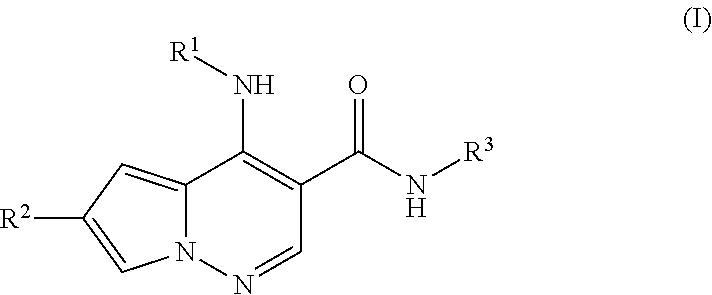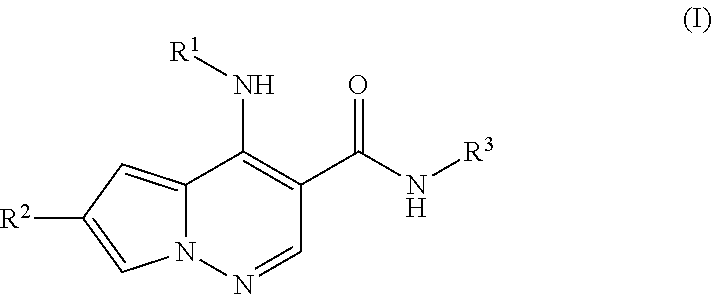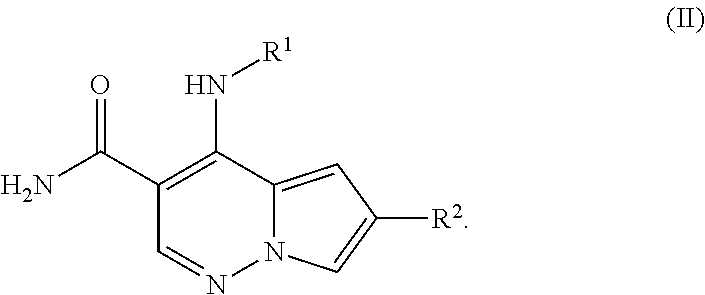Pyrrolopyridazine JAK3 inhibitors and their use for the treatment of inflammatory and autoimmune diseases
a technology of pyrrolopyridazine and inhibitors, which is applied in the field of pyrrolopyridazine compounds, can solve problems such as adverse hematopoietic effects
- Summary
- Abstract
- Description
- Claims
- Application Information
AI Technical Summary
Benefits of technology
Problems solved by technology
Method used
Image
Examples
preparation 3
4-chloropyrrolo [1,2-b]pyridazine-3-carboxamide
[0264]
[0265]To POCl3 (450 mL, 4.85 mmol) at 0° C. was slowly added ethyl 4-hydroxypyrrolo[1,2-b]pyridazine-3-carboxylate (from step 4 of Preparations 1 and 2, 100 g, 0.484 mmol) and the resulting mixture was stirred until complete dissolution. At this time, triethylamine (73.7 mL, 0.532 mmol) was added dropwise and the resulting mixture was heated at 110° C. for ˜16 h. After cooling to rt, the mixture was carefully concentrated in vacuo and the resulting dark brown residue was dissolved in dichloromethane and cooled to 0° C. This solution was carefully purged with ammonia gas for ˜45 min. And then it was allowed to stir at rt for 1 h. The solvent was removed under vacuum and the residue was diluted with ethyl acetate and water and the mixture was filtered through Celite. The organic portion was separated, and aqueous was extracted with ethyl acetate. The combined organic portions were dried over anhyd. sodium sulfate and concentrated un...
preparation 4
Ethyl 3-carbamoyl-4-chloropyrrolo[1,2-b]pyridazine-6-carboxylate
[0267]
Step 1: Ethyl 2-formamidoacetate
[0268]To a 5 L three neck round bottom flask equipped with a mechanic stirrer, a pressure-equalizing funnel and a condenser bearing a calcium chloride drying tube was added glycine ethyl ester hydrochloride (500 g, 3.583 mol) and methyl formate (1.8 L). The suspension was brought to reflux and triethylamine (556 mL) was added to the reaction. The reaction was stirred and refluxed overnight. The reaction was cooled to room temperature and filtered through a Buchner funnel to remove triethylamine hydrochloride salt. The filtrate was concentrated and dried over high vacuum to yield 320 g (93%) of the title compound.
Step 2: Ethyl 2-isocyanoacetate
[0269]To a round bottom flask was added ethyl 2-formamidoacetate (600 g, 4.5 mol), dry CH2Cl2 (6 L) and triethylamine (1.512 kg). The reaction mixture was cooled to −10° C. and then POCl3 (700 g) was added dropwise at −10° C. After the addition...
preparation 5
6-bromo-4-chloropyrrolo[1,2-b]pyridazine-3-carboxamide
[0275]
Step 1: 1-(4-Bromo-1H-pyrrol-2-yl)-2,2,2-trichloroethanone
[0276]To a 100 mL 3-neck round bottom equipped with a dropping funnel was added trichloroacetyl pyrrole (50 g, 236.4 mmol) and CCl4(1.0 L). After trichloroacetyl pyrrole was dissolved, the reaction was cooled to 0° C. and iodine (0.176 g) was added to the reaction. At this time, a solution of bromine (12 mL) in CCl4 (100 mL) was added dropwise very slowly to the reaction through a dropping funnel over 20 minutes and the resulting mixture was stirred at 0° C. for additional 20 minutes. The resulting mixture was transferred into a separatory funnel and washed with 10% Na2S2O3 solution, saturated NaHCO3 solution and brine (2×). The organic layer was dried and concentrated to give 50 g (60%) of the title compound as a white solid. LCMS (condition A): m / z=287.8, 289.8, 290.8 −ve. 1H NMR (400 MHz, CDCl3) δ ppm: 12.8 (1H, br.s), 7.56 (1H, m), 7.33 (1H, m).
Step 2: Methyl 4-b...
PUM
 Login to View More
Login to View More Abstract
Description
Claims
Application Information
 Login to View More
Login to View More - R&D
- Intellectual Property
- Life Sciences
- Materials
- Tech Scout
- Unparalleled Data Quality
- Higher Quality Content
- 60% Fewer Hallucinations
Browse by: Latest US Patents, China's latest patents, Technical Efficacy Thesaurus, Application Domain, Technology Topic, Popular Technical Reports.
© 2025 PatSnap. All rights reserved.Legal|Privacy policy|Modern Slavery Act Transparency Statement|Sitemap|About US| Contact US: help@patsnap.com



